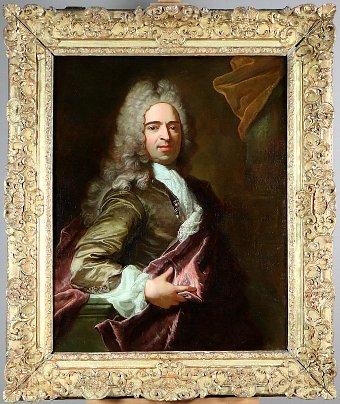featured item

quality pair of antique edwardian postal scales and weights Read more
Sophisicated Portraits
Posted by Amy Lugten on 29/06/2015
Writing about painting is a bit like writing about architecture. You have to absorb what the object is all about, in order to understand it. You have to know about who created it, why they created it, and who they created it for. Buildings are also much like portraits. They tell the story of a thing at a point in time, and they change with age. Our understandings of them change with age too. But like a fine architect, a fine artist’s reputation will endure, and this makes Old Master art all the more interesting.
On the website at the moment are three pieces of art (in two listings) that relate to two important artists of the early modern period.
Both artists also worked with their respective royalty. Hyacinthe Rigaud (1659-1743) most famously painted Louis XIV, the most outstanding of which is a full-length portrait of the King with scandalously exposed, white-stockinged legs. On the website at the moment is a work originating from the workshop of Rigaud. The work is in the style of Rigaud, and ‘workshop of’ generally denotes that, apart from originating from Rigaud’s own workshop, the master himself may have overseen elements of the work, drawn up the composition, or issued instructions for the work. There is nearly no doubt that the commission would have come to his workshop because of his own reputation. To some extent, clients may have stipulated a certain amount of input or work by the master himself, and some artists such as Rembrandt painted faces, for example, and had students complete the clothing and arms.
The other listing on the site to catch our attention this week was a pair of portraits attributed to John Closterman (1660-1711). Closterman is probably best known for his portraits of Queen Anne and also of the Duke of Marlborough, famous military leader during the War of the Spanish Succession, and owner of Blenheim Palace. Something of a journeyman, Closterman worked in Germany, Britain, Spain and Italy. Initially forced to leave England due to a dispute over the acquisition of a painting for the Duke of Somerset, Closterman painted the monarchs of Spain, and travelling before later returning to England for good. His work exhibits a fine attention to drapery and clothing, the area in which he made his name before initially moving to England. The works on offer in this listing exhibit good attention to detail, and are rather close and cropped, so we don’t get as big a look at the famed drapery of Closterman as we would like. Nevertheless, the figures themselves are painted beautifully, and its listing as ‘attributed to’ tells us that there is some merit in the work that could possibly make it by Closterman. If not, it was almost certainly created near the presence or work of Closterman, and there is possibly some further traces that could be found in archives.
Do look into the past of works that you admire – they might just be ‘sleepers’.




